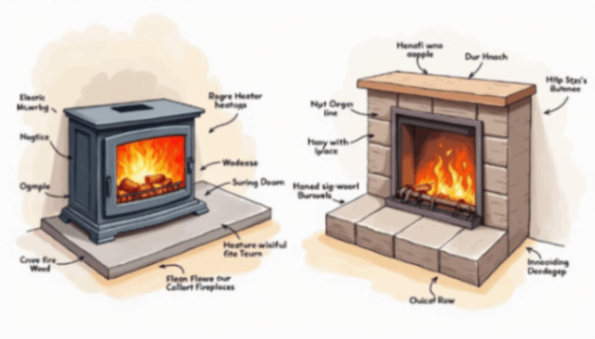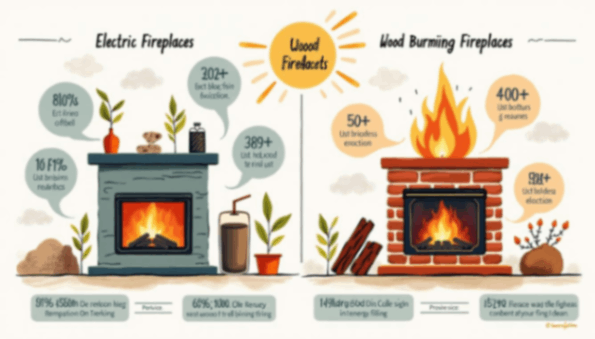As winter approaches, many homeowners face the dilemma of choosing the best heating option for their homes. Fireplaces have long been a symbol of warmth and comfort. However, the choice between electric and wood-burning fireplaces can significantly impact the ambiance, efficiency, and overall cost of heating your home. This article explores the fundamentals of these two popular fireplace choices and helps you determine which is the best fit for your needs.
Understanding the Basics of Fireplaces
Before making a decision, it is important to understand the basic differences between electric and wood-burning fireplaces. Each type has its own characteristics, functionalities, and design aspects that cater to varying preferences and requirements.

What is an Electric Fireplace?
An electric fireplace is a modern heating solution that uses electricity to create the illusion of flames, often accompanied by heat. These fireplaces come in various styles and designs, from wall-mounted units to traditional-looking mantel setups. One of the main advantages of electric fireplaces is that they require no venting, allowing them to be installed in virtually any room of the house.
Electric fireplaces include built-in fans that help distribute heat evenly, ensuring a comfortable living space. Additionally, they usually feature adjustable settings for both flame effect and heat output, giving homeowners complete control over their ambiance and comfort level. Many models also come equipped with LED technology, which not only enhances the realism of the flame effect but also contributes to energy efficiency, making them a sustainable choice for environmentally-conscious consumers. Furthermore, the safety features of electric fireplaces, such as automatic shut-off mechanisms and cool-to-the-touch surfaces, make them an appealing option for families with children or pets.
What is a Wood-Burning Fireplace?
A wood-burning fireplace is the quintessential choice for those seeking the traditional crackling fire experience. They operate by burning wood logs, creating both heat and an authentic flame display that many find appealing. Wood-burning fireplaces require proper ventilation, usually in the form of a chimney, to expel smoke and combustion byproducts outside the home.
While wood fireplaces create a cozy and nostalgic atmosphere, they do require regular maintenance to clean ash and soot buildup. However, the charm of a wood-burning fireplace is often worth the additional upkeep for many homeowners. The process of selecting the right type of wood can also enhance the experience; hardwoods like oak or hickory burn longer and hotter, providing a more sustained heat output and a delightful aroma that fills the room. Additionally, many enthusiasts enjoy the ritual of gathering and stacking firewood, which can foster a deeper connection to the natural elements and the changing seasons. This tactile interaction with the fireplace can transform it into a focal point of family gatherings and celebrations, creating cherished memories around the warmth of the fire.
Comparing the Features of Electric and Wood-Burning Fireplaces
When selecting a fireplace for your home, comparing key features can help make your decision clearer. Design, heat output, and installation requirements are vital considerations, and understanding them can lead to a more satisfying choice.
Design and Aesthetics
Electric fireplaces have come a long way in terms of designs and aesthetics. They are available in sleek, contemporary styles as well as more traditional designs that mimic wood-burning fireplaces. The flames produced by electric models are often adjustable in color and intensity, adding a customizable touch to your space. Many electric fireplaces also come with additional features such as built-in LED lighting and decorative logs, enhancing their visual appeal and allowing homeowners to create a unique ambiance tailored to their personal style.
Conversely, wood-burning fireplaces offer a classic, timeless appeal that many homeowners cherish. Their natural design can become a stunning focal point in a room, often combined with beautiful stone or masonry. The crackling sound of burning wood and the aroma of a real fire can evoke a sense of nostalgia and warmth that electric models may lack. However, their appearance is primarily dictated by the choice of materials and the fireplace's traditional structure. Homeowners often take pride in the craftsmanship of their wood-burning fireplaces, which can be customized with ornate mantels and intricate tile work, making each installation a unique work of art.
Heat Output and Efficiency
When considering heat output, electric fireplaces typically generate heat more quickly since they rely exclusively on electricity. This can be a more efficient way to achieve immediate warmth. Some models can also be used without the heat function, providing a cozy atmosphere without warming the room in milder weather. Furthermore, electric fireplaces often come equipped with thermostats and timers, allowing for precise control over the temperature and energy consumption, which can lead to lower utility bills.
Wood-burning fireplaces can provide significant heat output but require time for the fire to catch and produce heat. Their efficiency is dependent on the type of wood used and the design of the fireplace. While they can effectively heat a room, heat loss through the chimney during off periods can affect overall efficiency. Additionally, the burning of seasoned hardwoods can produce a more efficient and hotter fire, making the choice of fuel an important factor for those looking to maximize their fireplace's performance. Homeowners may also appreciate the sustainability aspect of using wood as a renewable resource, especially when sourced from local suppliers.
Installation and Maintenance
Installation requirements differ greatly between the two types of fireplaces. Electric fireplaces can simply be plugged into a standard outlet and do not need any special construction, making them easy to install in a variety of settings without the need for professional help. This flexibility allows homeowners to easily relocate or upgrade their electric fireplace as needed, adapting to changing tastes or home layouts.
In contrast, wood-burning fireplaces require more extensive installation. They often involve building a chimney and flue system, as well as complying with local building codes. Additionally, regular maintenance is essential, such as chimney cleaning and inspecting for potential hazards. This ensures your fireplace is safe and functional while also preserving its aesthetic appeal. Homeowners must also be mindful of the need for proper wood storage and seasoning, as well as the potential for creosote buildup, which can pose a fire risk if not addressed. The commitment to maintaining a wood-burning fireplace can foster a deeper connection to the home and the art of fire, making it a rewarding endeavor for those who appreciate the traditional aspects of heating.
Evaluating the Costs
Understanding the costs associated with both electric and wood-burning fireplaces can play a critical role in making your decision. Initial purchase prices, installation costs, and ongoing expenses related to operation all contribute to the end financial picture.

Initial Purchase and Installation Costs
Electric fireplaces are generally more affordable than their wood-burning counterparts. Prices for electric models can range from a few hundred dollars to a couple of thousand, depending on the style and features. Installation, often a simple task, usually incurs minimal costs.
Wood-burning fireplaces typically have a higher initial purchase and installation cost. Prices for wood-burning units can range significantly, and professional installation is highly recommended. This can add several thousand dollars to the overall cost due to materials and labor required.
Ongoing Costs and Energy Efficiency
When considering ongoing expenses, electric fireplaces tend to be more predictable. The cost of electricity and potential heating efficiency allows for straightforward budgeting. Additionally, electric fireplaces often have lower maintenance costs since they do not require chimney cleaning or other related upkeep.
Wood-burning fireplaces, while providing a traditional experience, can incur higher ongoing costs. Expenses for buying wood, maintaining the chimney, and potential repairs can add up quickly. However, some homeowners may consider the cost of firewood as an investment in their heating strategy, particularly in rural areas where wood is plentiful and inexpensive.
Safety Considerations for Electric and Wood-Burning Fireplaces
Safety is imperative when heating your home with a fireplace, and both electric and wood-burning options come with unique safety considerations that should be closely evaluated.
Fire Safety and Risks
Electric fireplaces are generally considered safer than wood-burning fireplaces. They come equipped with safety features, such as automatic shut-off switches and thermal sensors, that help prevent overheating. The absence of open flames and combustion significantly reduces the risk of house fires.
On the other hand, wood-burning fireplaces pose a higher risk of fire due to their open flames and the potential for embers to escape. Proper use and maintenance, including regular chimney inspections, are crucial for minimizing risks associated with wood-burning heating.
Indoor Air Quality and Health Impacts
Electric fireplaces contribute positively to indoor air quality, as they do not produce combustion byproducts. Those with respiratory issues can benefit from this feature, making electric units an attractive option for sensitive individuals.
Contrastingly, wood-burning fireplaces can lead to indoor air quality concerns due to the smoke and particulates released during combustion. Homes with wood-burning units must ensure adequate ventilation and regular maintenance to mitigate pollutants and ensure a healthy indoor environment.
Environmental Impact of Electric and Wood-Burning Fireplaces
As environmental concerns grow, the ecological footprint of your fireplace choice becomes increasingly significant. From carbon emissions to the sources of energy, understanding the environmental impacts of each fireplace type can influence your choice.

Carbon Footprint and Emissions
Electric fireplaces can have a lower carbon footprint if the electricity used is generated from renewable sources. However, the emissions can vary significantly depending on how the local electricity is produced, which can involve fossil fuels.
Wood-burning fireplaces emit carbon dioxide during combustion, impacting air quality and contributing to greenhouse gases. However, using sustainably sourced or seasoned wood can reduce the overall environmental impact, as it can be a renewable energy source when managed responsibly.
Sustainable and Renewable Energy Sources
Many individuals are now seeking eco-friendly solutions for heating their homes. Electric fireplaces can contribute to sustainability when paired with renewable energy sources such as solar or wind power. Opting for electricity generated from these methods can offer a greener heating option.
Conversely, wood-burning fireplaces can also be sustainable when utilizing responsibly harvested woods. Homeowners can engage in practices such as replanting trees and sourcing wood from sustainable suppliers, thus mitigating the environmental impacts of their heating choices.
In conclusion, both electric and wood-burning fireplaces offer distinct advantages and drawbacks. A homeowner's lifestyle, budget, and preferences will ultimately dictate which type is the best fit. By understanding the various aspects of each option, you can make an informed decision that will enhance your home's comfort and ambiance for years to come.











